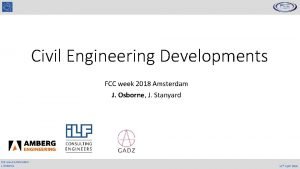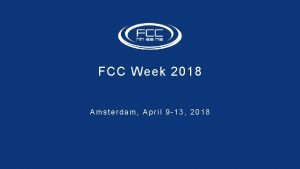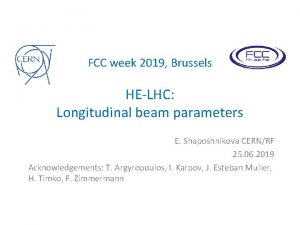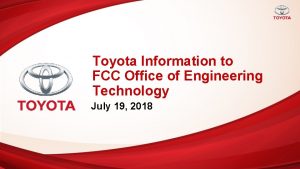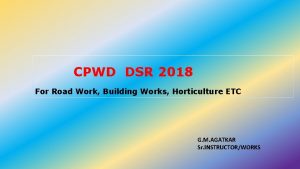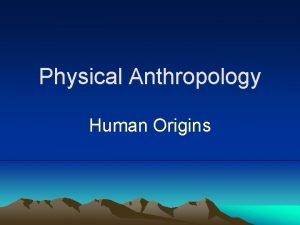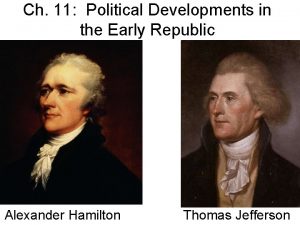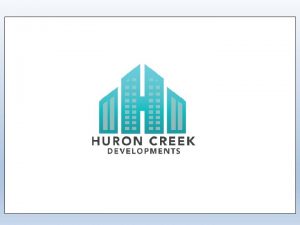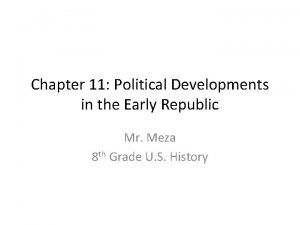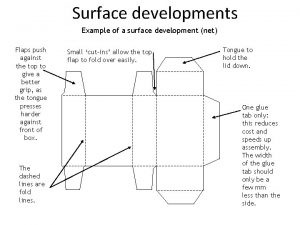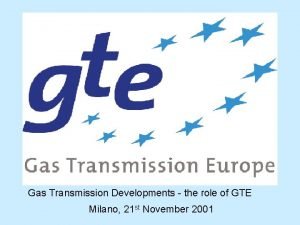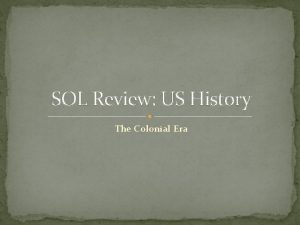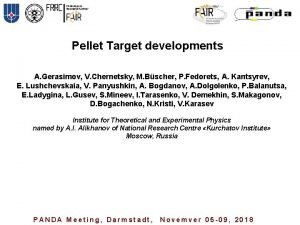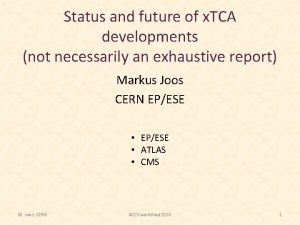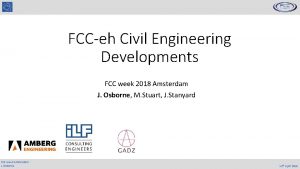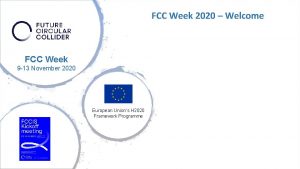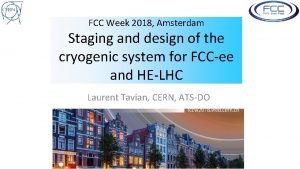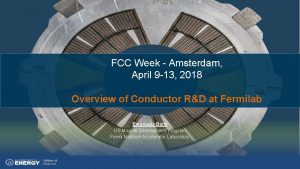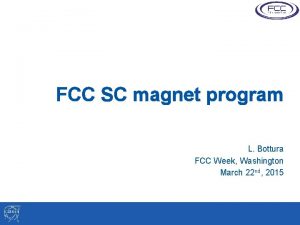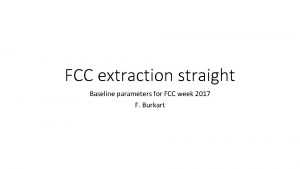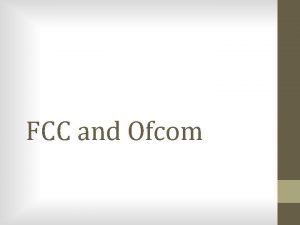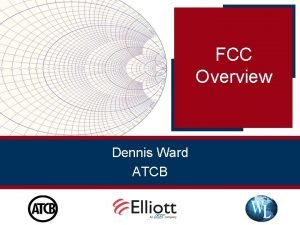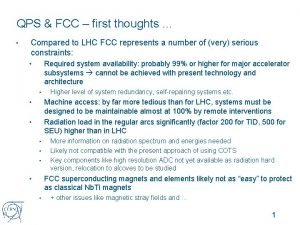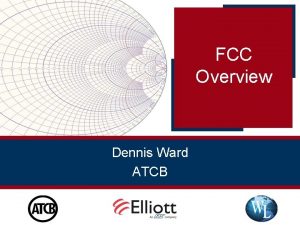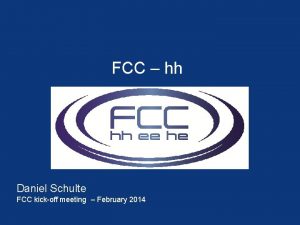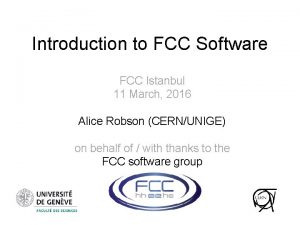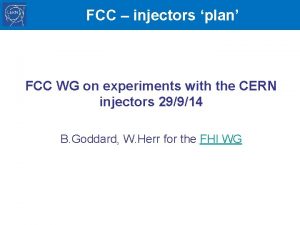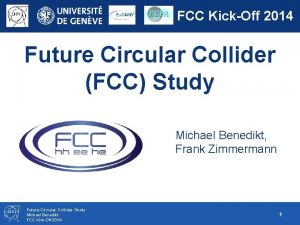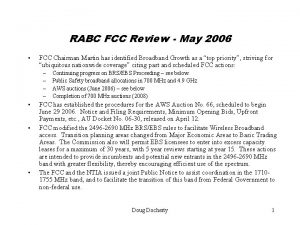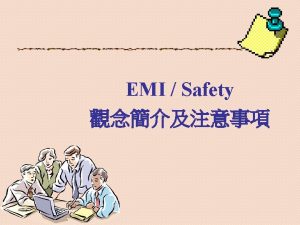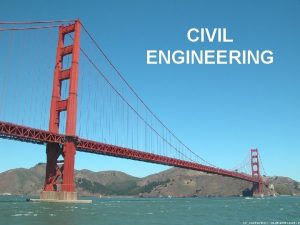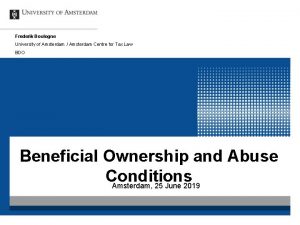Civil Engineering Developments FCC week 2018 Amsterdam J























- Slides: 23

Civil Engineering Developments FCC week 2018 Amsterdam J. Osborne, J. Stanyard FCC week Amsterdam J. Osborne 11 th April 2018

Agenda • Civil Engineering study progress since Berlin 2017 • Scope of Civil Engineering for: • FCC-hh • FCC-ee • FCC-eh • HE-LHC • Alignment and Geology Update • Update on the principal structures and position • Typical tunnel cross-section • Experimental cavern layout options • Cost and Schedule Study • Spoil Management Study • Ground Investigation planning and Future Steps FCC week Amsterdam J. Osborne 11 th April 2018

Study progress 2017/18 Alignment update following geological review of key areas: • Lake crossing • Arve and Rhone Valleys Led to the lowering of the alignment by 30 m. Phase 3 of cost and schedule study launched. • Refinement of results from previous phases • Produce a cost and schedule estimate that is compatible with the CDR baseline. Design development with integration, including study to investigate feasibility of interaction region layout. • Cost and schedule round up for all 3 machines: FCC-hh, FCC-ee and FCC-eh • CDR writing Ongoing work: • Surface site investigation • Spoil management study • Site investigation planning • HE-LHC feasibility and cost • Transfer line design August 2017 FCC week Amsterdam J. Osborne September 2017 February 2017 March 2018 Ongoing 11 th April 2018

Scope of FCC-hh Shafts: Experimental Shafts: 15 m dia. + 10 m dia. Service shafts: 12 m dia. Magnet delivery shaft: 18 m Small Experimental Caverns • 30 m x 35 m x 66 m Dump Caverns Large Experimental Caverns • Service Caverns • 25 m x 100 m FCC week Amsterdam J. Osborne • 10 m x 50 m 35 m x 66 m Tunnels: • 97. 75 km of 5. 5 dia. machine tunnel • Approx. 8 km 5. 5 dia by-pass tunnels 11 th April 2018

FCC-ee • Would be constructed at the same time as FCC-hh • Infrastructure must be able to accommodate both machines. • Enlargements required at experiment points A and G. FCC week Amsterdam J. Osborne 11 th April 2018

FCC-eh Civil Engineering of FCC-eh – J. Osborne Thursday 12 th April 9: 00, Berlage Zaal 1. 9 FCC week Amsterdam J. Osborne 11 th April 2018

HE-LHC • For HE-LHC modifications are required to house a new accelerator, including: • Cryogenic caverns and buildings • Installation of fire separation walls including extension of the tunnel envelope each 400 m • Maintenance of the existing structure. Crossrail – Cross Passage Temporary Frames FCC week Amsterdam J. Osborne Brisbane – Airport Link (Similar ground to CERN) 11 th April 2018

Introduction to the geology of the Geneva Basin Moraines • Glacial deposits comprising gravel, sands, silt and clay • Water bearing unit • Low strength Molasse • Mixture of sandstones, marls and formations of intermediate composition • Relatively dry and stable • However, some risk involved: structural instability (swelling, creep, squeezing) Limestone • Hard rock • In this region fractures and karsts encountered • High inflow rates measured during LEP construction (600 L/sec) • Clay-silt sediments in water filling karsts FCC week Amsterdam J. Osborne 11 th April 2018

Alignment Update Following another round of geological review of the most challenging areas this is the baseline position considering: • Lowest risk for construction • Fastest and cheapest construction • Feasible positions for large span caverns (the most challenging structures) Not considering: • Results from initial feedback on surface site locations FCC week Amsterdam J. Osborne 11 th April 2018

Geology under lake • Data available from boreholes and seismic scans for potential lake road crossing. • Tunnel to cross moraine layer below lake. • Layered moraine types, improving in quality with depth. However, the deeper the tunnel in the moraines, the greater the pressure on the tunnel gaskets. Conclusion: Lower alignment by 30 m in order for the tunnel to be at a depth with a reduced construction risk and that will not be affected by changes in the lake depth during the operation phase. Construction method: Slurry TBM FCC week Amsterdam J. Osborne 11 th April 2018

Geology of Rhone and Arve valleys • Data available from deep destructive drillings for water research in the vicinity of the crossing. • Data available from oil surveys, destructive drillings and geological maps. • Tunnel previously crossing saturated moraines below Rhone in NATURA 2000 protected area. • Tunnel previously crossing moraine later, including permeable layers (shown in yellow) Conclusion: Lower alignment by 20 m so that the TBM mode does not need to be changed and environmental risks are minimised. FCC week Amsterdam J. Osborne 11 th April 2018

Geological Uncertainty along Alignment Seismic and borehole information for lake crossing from proposed road tunnel, but layered nature of lake bed leads to uncertainty. • • • Information near to CERN is strong due to previous experience on LEP/LHC. Multiple deep boreholes in the area. A B C • Location of the interface between molasse and molasse subalpine not certain, tunnel alignment in proximity. • Moraine/molasse interface not certain, cavern close to interface. Lack of deep boreholes in area. L D K • Alignment close to limestone rockhead E J F • Limestone formation known, but characteristics and locations of karsts unknown. FCC week Amsterdam J. Osborne I H G • • No deep borehole information available in the area. Complex faulted region. Molasse/limestone interface not certain. 11 th April 2018

Typical tunnel cross-section Steel structure with passive fire protection. Connection: Pre-cast concrete segmental lining Cast-in-situ concrete invert Pre-cast concrete element FCC week Amsterdam J. Osborne 11 th April 2018

Point F options Option 576 m Shaft 10% inclined access 15% inclined access Excavation length 576 m (12 m. ID) 3820 m (9. 0 m. ID) 2750 m (9. 0 m. ID) Total duration (months) 22. 2 25. 8 23. 2 Relative CE Cost 1 1. 08 0. 78 Advantages • Shorted length of services • Improved surface site location • Improved surface site and access location and access • TBM ready in cavern for tunnel • TBM ready in cavern for excavation tunnel excavation Disadvantages • Baseline lift mechanism not feasible • Surface site has difficult access • Increased length of services • Transport method at 15% to be confirmed Existing LEP transfer tunnel TI 18 15% from SPS to LHC Whole project cost and schedule implications, including transport and services, still to be evaluated. FCC week Amsterdam J. Osborne 11 th April 2018

Junction cavern refinement • Junction caverns are required for structural stability when tunnels of similar size connect. • By evaluating each case individually, it was possible to omit some junction caverns • The remaining caverns have been grouped into 3 types. (Type 1 below indicates no cavern is needed) Seite 15 FCC week Amsterdam J. Osborne 11 th April 2018

Experimental point layout options • With 45 m spacing in good molasse, the rock pillar alone is sufficient. • Cheapest and lowest risk option for CE FCC week Amsterdam J. Osborne • With a 10 m spacing it is feasible but a high strength concrete pillar is required. 11 th April 2018

Cost and schedule study progress Phase 1 Cost & Schedule estimate for “baseline” single tunnel design. FCC week Amsterdam J. Osborne Phase 2 Phase 3 Cost & Schedule implications of variations considered: Refinement of results from Phases 1 and 2: • Double tunnel design • Shallow option • Alternative tunnel diameters • Alternative shaft diameters • Alternative cavern dimensions • ee machine requirements • Alternative schedule + Inclined access tunnels • Review to include updates made to baselined design. • Incorporate desirable variations from Phase 2. 11 th April 2018

Construction Strategy Additional construction lots • 2 no. Shafts near the LHC for the connection tunnels LHC-FCC • 2 Beam transfer tunnels Access to main tunnel works through: • Shafts at 11 points • Sloped Access adit at 1 point (instead of 570 m shaft) Project divided in 12 construction lots Construction techniques: 1) TBM tunnels (red) 2) Mined tunnels (blue) FCC week Amsterdam J. Osborne Intermediate Access Adits • necessary to cope with overall time schedule to meet deadlines for machine installation 11 th April 2018

Construction Schedule Sector L-B : 4. 5 years FCC week Amsterdam J. Osborne Sector D-F : 6. 5 years 11 th April 2018

Spoil Management Assumed bulking factor of 1. 3 FCC week Amsterdam J. Osborne Production of up to 42, 000 m 3 per month 9 million cubic meters to dispose Can the molasse be re-used? 11 th April 2018

Ground Investigation Planning Types of site investigation: • • • FCC week Amsterdam J. Osborne Collection of existing information Walkover survey Geophysical investigation Boreholes Site testing (eg Insitu stress test, point load testing, SPT) Rock laboratory testing. Geothermal site investigation in Satigny 2017/2018 (500 m deep) 11 th April 2018

Other Future Steps • A further round of alignment optimisation following input from surface site investigations and potentially ground investigations • Continuing to work with integration to refine designs for all structures • Spoil disposal planning • Development of HE-LHC requirements • Maintenance planning for injection chain. FCC week Amsterdam J. Osborne 11 th April 2018

 Fcc amsterdam
Fcc amsterdam Fcc amsterdam
Fcc amsterdam Fcc week 2019
Fcc week 2019 Fcc office of engineering and technology
Fcc office of engineering and technology Civil rights webquest
Civil rights webquest Week by week plans for documenting children's development
Week by week plans for documenting children's development Dsr horticulture 2018
Dsr horticulture 2018 Dsr 2018 civil
Dsr 2018 civil When is healthy eating week 2018
When is healthy eating week 2018 B a f c j e
B a f c j e Recent developments in ict
Recent developments in ict Recent developments in object detection
Recent developments in object detection Cultural developments of sahelanthropus tchadensis
Cultural developments of sahelanthropus tchadensis Peter rosenwald
Peter rosenwald Political developments in the early republic
Political developments in the early republic Huron creek developments
Huron creek developments Political developments in the early republic
Political developments in the early republic Netflaps
Netflaps Transmission developments
Transmission developments In the colonial era developments such as the new england
In the colonial era developments such as the new england Target developments
Target developments Patterns of development comparison and contrast examples
Patterns of development comparison and contrast examples Pattern development
Pattern development Comtel atca
Comtel atca
